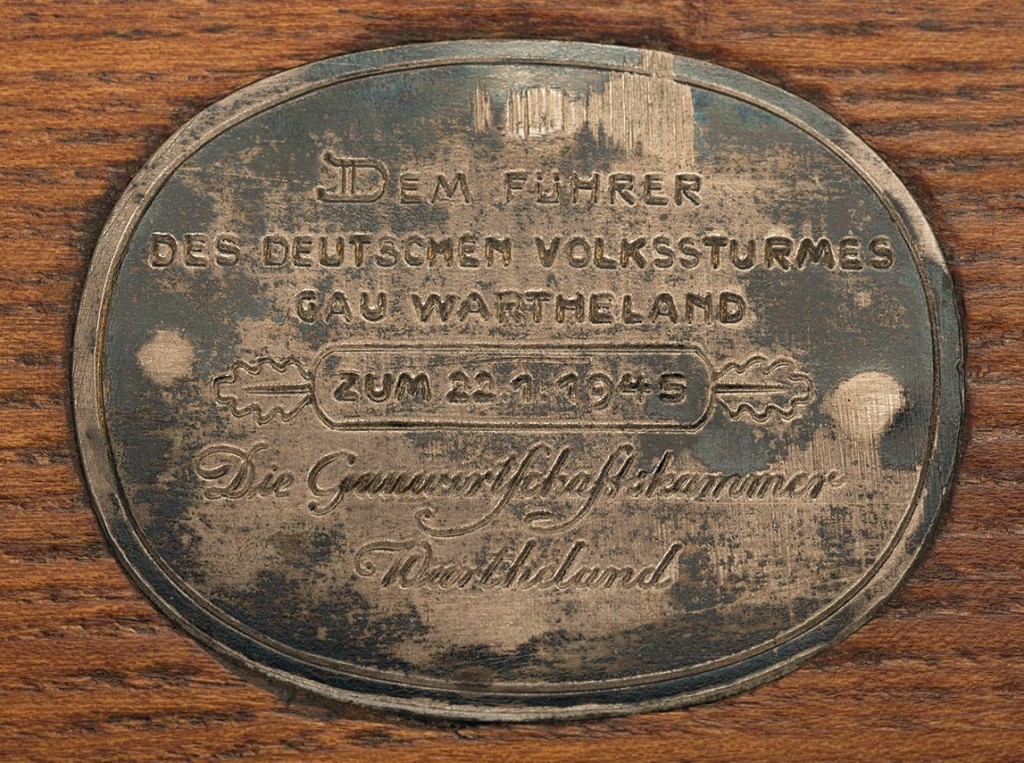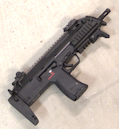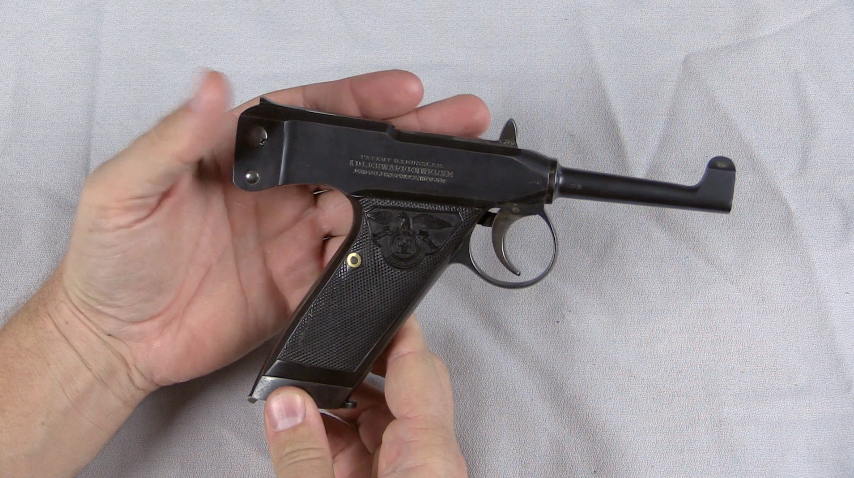So, I was browsing through the catalog for Rock Island Auction’s upcoming Premier Auction (I’ll have more next week on the various neat things available), and found one item in particular that jumped out at me as so very incongruous:

Yep, it’s a presentation-grade Volkssturm VG-1 rifle. The plaque on the stock, roughly translated, reads “To the Leader of the Peoples Army Wartheland from the Wartheland Economic Chamber of Commerce” and is dated January 22, 1945. Wartheland was an area of Greater Poland around the city of Poznań, which was taken over by Germany in 1939. The Peoples’ Army Leader this rifle was made for would have been Arthur Greiser, a devout Nazi and enthusiastic proponent the Holocaust. Happily, he was tried and convicted of numerous war crimes and hanged on July 21, 1946.
 For those who aren’t familiar with it, the VG-1 was a last-ditch rifle design that really represented the last gasp of the German arms industry. They are quite valuable today, of course, as not that many survived the war, but in January of 1945 being handed one would really bring home the desperation of the German war effort. Making an official presentation of one for a senior official would be a quintessential example of attempting to polish a turd. I would imagine that simply suggesting the VG1 design to Obergruppenfuhrer Greiser in 1940 would have gotten one a quick execution for insulting the Reich’s capabilities.
For those who aren’t familiar with it, the VG-1 was a last-ditch rifle design that really represented the last gasp of the German arms industry. They are quite valuable today, of course, as not that many survived the war, but in January of 1945 being handed one would really bring home the desperation of the German war effort. Making an official presentation of one for a senior official would be a quintessential example of attempting to polish a turd. I would imagine that simply suggesting the VG1 design to Obergruppenfuhrer Greiser in 1940 would have gotten one a quick execution for insulting the Reich’s capabilities.
Should you want to make this piece yours, you can see the full auction listing here: Unique Documented Late World War II Last Ditch Nazi Presentation DWM VG1 Bolt Action Rifle




Wow…just…wow.
That is one of the craziest things I’ve ever seen.
I wonder if there is a presentation Liberator out there somewhere?
Or an engraved RG14s…
Or a gold-inlayed HiPoint…
*sigh*
probably.
Thanks for the picture of a true anachronism!!
Definitely a unique historical artifact, so pricey. But you can always get more money. One remark so on the Wartheland region, it was part of the area Germany lost under the Versailles treaty. To the Germans at the time that made it part of Germany, not Poland. It had a mixed Polish-German population, as in feudal times the idea of a homogenous population was an alien concept. Only after WWII would the area be ethnically cleaned of Germans as the Germans had used the German minority as an excuse for the attack (similar to the situation in Czechoslovakia with the Sudetenland).
One of my headmasters when I was at school, had, as a somewhat younger man, been with the Red Cross at the time Poland and the Baltic States were cleansed of those identified as German.
He didn’t say much about the experience, but the terms “cattle trucks”, “Typhus” and “brutality” were all in there.
I was too young and generally in the wrong position (I was often sent to see him for some misdemeanor or other) to ask him about what he had seen.
Thinking about this
anyone who says Germans don’t have a sense of humor, has a lot of explaining to do about this rifle and the level of gallows humor in its presentation
It’s pretty much saying “Now we’re completely effed, and you played a big part in us getting into the situation, but now you’re going to grit your teeth and pretend to smile while you’re presented with this symbol of desperation. Hope the hangman gives you enough slack.”
+1! “Gilding the lily” indeed! Not just a “symbol of desperation” but with the silver presentation disk [don’t ask about the source of silver in Wartheland, me things… Ugh! :X] mounted in the butt, a symbol of Nazi delusion at its height… Or depths…
the Text say in german
Dem Führer
Des Deutschen Volksturm Gau Wartheland
Zum 22 .1. 1945
Die Gauwirtschaftskammer Wartheland
In English
To the Leader of the German national resistance of the empire-shire Wartheland
At january 22, 1945
by Shire chamber of commerce Wartheland
Wartheland was piece of Poland, transform to Reichgau (empire-shire) by Nazi
http://en.wikipedia.org/wiki/Reichsgau_Wartheland
the Date is irony because on january 23, 1945 the Red army had conquer entire Wartheland.
after 11 day of fighting there way from east to west.
if this data is right, then the Leader of Volkssturm in Wartheland certain Kurt Schmalz
(Schmalz mans in English greasy)
http://de.wikipedia.org/wiki/Kurt_Schmalz
i hope those Information were helpful
are there any modern day reproductions made of this rifle ?
Sure… Except now it comes with a plastic polymer stock in lieu of the rough beech wood and without the K43 10-shot box magazine… It is called the Ruger “American Rifle” nowadays… Ha-ha! j/k! :))
Srsly though: There is a German militaria firm that makes inert steel non-firearm model/reproductions of the Volksmachinepistole aka. Neumünster Gerät aka “MP3008” aka even-cheaper-to-build-than-Sten Mk. III-disposable-pistol-bullet-launcher but NEITHER the Walther VG1 [pictured] nor the Spreewerke even-cheaper-to-build VG2! What gives?! The same outfit makes a tremendous and awesome copy of the Polish “Lightning” 9mm SMG from August 1944 renown, but none of the Volksgewehre.
If I could only have one collector rifle, this is the one it would be. I find Volkssturm weapons interesting and this one from Posen would be the ultimate one. An instant family heirloom.
careful, if the german government learns of this rifle, they might ( as the Polish government has) declare it a national treasure and ask the state department to seize it for reperation. so much for due process
It should be in a museum, whether you like it or not.
My right to property usurps your ridiculous anecdote.
I’m with Suggs. Museums are struggling from lack of attendance there days, anyway. …welcome to the internet,
No one has a valid right to confiscate it for a museum, but I do hope the buyer donates or loans it to the National Firearms Museum, which is a perfect place for such a unique and historically significant rifle. If they don’t, it’ll be their property so they can do what they want with it.
I would rather the ownership of a rare gun be in private hands in these questionable times, however that being said, I also think that just because a rare gun is in private hands dos not necessarily mean it must vanish from the public view!
Think of all the rare guns In the videos shown here, both those owned by the Forgotten Weapons crew and those that are loaned to them by individuals for the making of dis-assembly and firing videos! I also support programs through which individuals can LOAN guns to museums. Or the case of smaller veterans museums and such, which are basically private collections with public viewing hours! (…Come back next weekend, and ‘ol Bill is gonna oil up his MG13 there and we’re gonna shoot it!)
I love gun shows where you find tables where the guns are not for sale, but owned by the proud, grinning couple who plopped down a hand full of cash just to come and SHOW them to the people who really do care about seeing them. Thanks to men and women like that, I have with their permission held extremely valuable antiques and incredible NFA weapons that I will probably never be able to afford to own.
How many Museums will not just let, but instruct, a curious 16 year old to pick up and hold a Colt Thompson just to see how heavy it really is? Thirty years later that memory is still with me thanks to a private collector, as are memories of B.A.R.’s Colt Lightnings, an artillery Luger with all the goodies, an M3 grease gun, an original Sharps…. Just thinking about them has me in dreamland again.
Thank you Forgotten Weapons, and Thank You generous, proud, grinning, knowledgeable, private collectors.
You’re dead on, Jamez. We’ve never been able to shoot a gun in a museum collection, and only once that I can remember were we able to disassemble one (the Cei Rigotti). Museums allow a lot of people to look at items, but only on the wall and usually behind glass. Private collections are much more difficult to get access to (you’ve got to know the right people), but they are also far more likely to allow you to actually learn things about the guns – disassemble them, shoot them, etc. It’s really a tradeoff…
Morning All …Seems to me after reading all this about whether a particular weapon should or should not be in a museum kinda boils down to the basic question which is what is the American way of doing things. 1st .. I would estimate that at least 90% of weapon types are not of a historical value and the general public only has an interest in seeing the “type” weapon used carried by, or belonging to etc. Museums are; in most cases; not displaying all the weapons they have received by donation. Most are in fact packed away in the basement for “research” and will never be seen. 2nd .. A vast majority of the “collectable” weapons are of interest to collectors only and by specific type etc. Example are the many weapons currently being advertised by Rock Island Auctions. Few people will pay 30 or 40,000 dollars for a single weapon. Unless it is like the Ted Dalton revolver or maybe Gen Patton .357 etc. Most non collectors, everyday folks, would not recognized what they were even if displayed; and only if a tag was provided to provide the information. 3rd .. In this country if you can afford it, if you want it bad enough,if it is legal, you can buy it. Most weapons bought by collectors are from auctions, pawn shops, gun shows, estate sales and are therefore available to anyone and the person that is willing to pay what is being ask. I own a 1st Alabama Volunteer Cavalry Smith .54 Carbine. This unit fought as a “northern unit”; yes for the North. I was willing to pay for it and a lot of other folks were not. What I do with it is up to me and no one else. I have been out bid a dozen times for Colt US marked 7 1/2″ .45’s. Someone else wanted them more than I did. I am not going up on the roof and jump off. That’s America. Just my thoughts as I look at my collection.
Thomas, that’s a pretty good insight into some of the whys and wherefores of “collectible” firearms in this country ( and perhaps elsewhere too, with variations ). Thanks.
For a last-ditch rifle, the VG-1 actually appears to be reasonably well-made. Having said that, I only have photographs to go by. Has anyone on this site actually handled one — perhaps he or she can provide a better insight.
All … A side note ..the 3 volume set of catalogues for the up coming auction are 1st Class beautiful color and wonderful references for data on some of the weapons but also as a kinda “asking” price guide for future reference. Later after auction they publish a “hammered amount received”. //
Great information to have in hand — thanks, Thomas!
I have seen a half-dozen VGs and no two are the same. Some of them are new manufactured receivers and some are whatever was lying around — old 98a’s from the First War.
One think Hitler’s demand for territorial integrity of the German people inside a German nation produced was more ethnic Germans (Volksdeutsche) in a much smaller Germany than he figured. Every nation that had come under the Nazi boot expelled most or all of its ethnic Germans and they resettled, penniless, in Germany. It was “ethnic cleansing” before that term was cool, and there was very little sympathy for the German refugees… their nation had infuriated the world.
A lot of lines on the map of Europe moved (and a lot of nominally independent countries were de facto slave states for the next 40 years), and when the lines were done moving there were a lot fewer ethnic minorities in other ethnicities’ countries.
Stability and peace — the hard way.
Fewer “Germans” certainly,
but Stalin, like Lenin and Trotsky, and every other nationalist rabble rouser in history, knew the value of planting enclaves of minorities everywhere.
Soviet and soviet satellite identity papers were as meticulous about recording ethnicity as any officious little apartheid bureaucrat in South Africa ever was.
And for the same purpose; divide and rule, and as a pretext for military action to protect some group or other.
So, far from the romantic days of “pan Slavism” the likes of the present day baltic republics all have planted populations of “ethnic Russians”, to provide a pretext for some present or future nationalist to “protect”.
Unlike the now largely expelled “Germans” from all around eastern Europe, who’s ancestors had usually chosen to peacefully settle (there are still former mining villages all around the mountains of eastern europe where the villagers speak forms of medieval German), I don’t think the populations planted by the Soviets had much choice in the matter, but that is where they have had to build their lives and raise their families, and it would be an equal injustice to expel them.
I had several VG 1 and I have fired it on the range. It is a well developed system. The bolt has only the fiting pin, the spring and a spring retainer, that is all!!Both mine had the code for Walther, who normaly is blamed for the construktion.
Didn’t most of these rifles have surplused Luftwaffe MG.15 and MG.81 barrels? The VG.1 I handled had an MG.15 barrel with a ‘dot’ manufacturer’s code.
Yes, according to W. Darrin Weaver’s _Desperate Measures_ the Walther VG1 was selected as the best single 7.92x57mm Volkssturmgewehr rifle design. The barrels were from obsolete ex-Luftwaffe 8mm machine guns: MG15, MG17s and MG81s. Those same machine guns, if it was still fully functional and not just a barrel, were modified for use in a ground role and turned over to Volkssturmmänner to delay the Soviets.
The Walther VG-1 cost 5 USD to build at a time when even the ultra-Spartan Kriegsmodell K98 still cost too close to 25 USD to build. That’s about 65 to 70 dollars in today’s dollar values… Or about the bulk dealer price of the old obsolete Mosin-Nagant 1891/30!
Caliber: 7.92x57mm
Mechanism: Bolt-action repeater
Overall length: Depending on barrel used, from 930 to 1,033mm or 36.6 to 40.6 inches [same length as Soviet M44!]
Barrel length: Again variable since M.81 had shorter barrel, but around 400mm
Weight 3.3kg or 7.3lbs give-or-take
Front sight: pyramid or post, some milled for a protective sight hood
Rear sight: Fixed U-notch set for a 100 meter/ 110 yard “zero.”
The bolt had two front locking lugs, a stamped, sheet-metal striker with a case hardened tip and a milled spot for the mainspring retaining ring, a mainspring, a an extractor with its spring, and a couple of washers.
I’d frankly love to have one… Unless it was among those built at KZ Neuengamme just south of Hamburg…;(
I actually like this rifle. The plaque makes it even more interesting.
Thanks for posting.